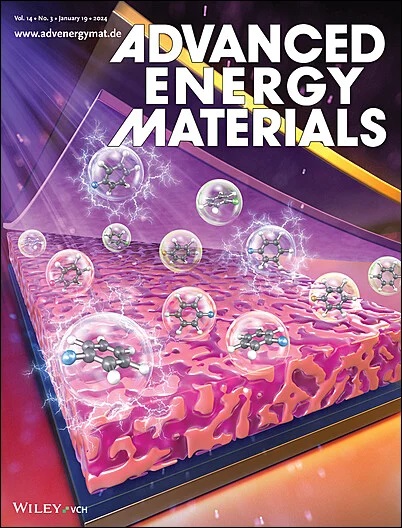协同改善空穴传输单层的结构有序性和界面结合,实现高效反相包晶石太阳能电池
IF 24.4
1区 材料科学
Q1 CHEMISTRY, PHYSICAL
引用次数: 0
摘要
本文章由计算机程序翻译,如有差异,请以英文原文为准。

Synergistic Improvement of Structural Ordering and Interface Binding of Hole Transport Monolayer for Efficient Inverted Perovskite Solar Cells
The widespread application of self-assembled monolayer (SAM) hole transport materials has driven rapid advancements in the performance of inverted perovskite solar cells (PSCs). However, the difficulty of achieving a highly ordered SAM for hole transport and the weak binding strength between SAM and the perovskite layer not only leads to defective bottom interface but also reduces the compatibility with the large-area device fabrication. In this work, a co-assembled molecule functionalized with a diamide terminal group is demonstrated that is able to form supramolecular interaction with popular carbazole-based SAMs for regulating their structural ordering, and to improve the chemical bonding with perovskite Pb-I frameworks synergistically, which enables efficient and long-term stable inverted PSCs. As a result, the target co-assembled SAM contributes to a champion small-area device with a power conversion efficiency (PCE) of 25.3% (certified 25.0%), and demonstrates good compatibility with large-area fabrication by achieving highly reproducible performances in 1.02 cm2 devices. The encapsulated devices exhibit good stability with 92.8% and 91.2% of initial PCE after 1500 hours of aging under 85 °C and maximum power point (MPP) tracking at 65 °C for 1500 hours, respectively.
求助全文
通过发布文献求助,成功后即可免费获取论文全文。
去求助
来源期刊

Advanced Energy Materials
CHEMISTRY, PHYSICAL-ENERGY & FUELS
CiteScore
41.90
自引率
4.00%
发文量
889
审稿时长
1.4 months
期刊介绍:
Established in 2011, Advanced Energy Materials is an international, interdisciplinary, English-language journal that focuses on materials used in energy harvesting, conversion, and storage. It is regarded as a top-quality journal alongside Advanced Materials, Advanced Functional Materials, and Small.
With a 2022 Impact Factor of 27.8, Advanced Energy Materials is considered a prime source for the best energy-related research. The journal covers a wide range of topics in energy-related research, including organic and inorganic photovoltaics, batteries and supercapacitors, fuel cells, hydrogen generation and storage, thermoelectrics, water splitting and photocatalysis, solar fuels and thermosolar power, magnetocalorics, and piezoelectronics.
The readership of Advanced Energy Materials includes materials scientists, chemists, physicists, and engineers in both academia and industry. The journal is indexed in various databases and collections, such as Advanced Technologies & Aerospace Database, FIZ Karlsruhe, INSPEC (IET), Science Citation Index Expanded, Technology Collection, and Web of Science, among others.
 求助内容:
求助内容: 应助结果提醒方式:
应助结果提醒方式:


